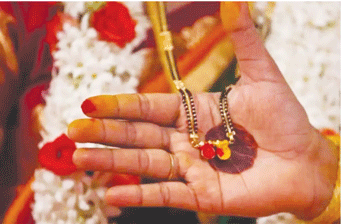HERITAGE: The mangalsutra and saree as much as the salwar kameez are all part of the Indian cultural tradition. The Catholics may wear a special white wedding gown and many Muslim bride wear burqa, but the mangalsutra is still the symbol of a young woman’s marriage status
By Lhendup G Bhutia
The mangalsutra is not an exclusively Hindu tradition which symbolises the married women. It is part of the heritage of Indian culture with the minority communities, including the Christians and Muslims who are also wearing the mangalsutra as a mark of their new marriage status
The mangalsutra and the evolutionary symbolism of marriage
Last year when Shardul Kadam and Tanuja Patil began to plan their wedding, they decided that every aspect of their married life would be based on the concept of gender equality. The Pune-based couple was going to share the cost of their wedding, and Patil would not carry her husband’s last name. But since their wedding in December 2020, they have continued to practise this concept in everyday life, dividing household chores and duties, for instance, based on interest and skills instead of gender-defined roles. So, Kadam cooks and shops for the house and kitchen, while Patil, a chartered accountant, makes financial decisions and investments. “That’s because our interests lie there,” says Kadam, who works as a marketing consultant.
But as their wedding day approached last year, it occurred to Kadam, he says, that even marital traditions must be based on equality. So, at their wedding, while Kadam did tie the mangalsutra around Patil, she too tied one specifically designed for a male around his neck. Most of the women gathered were overjoyed by the gesture, Kadam recalls, while the men snickered behind his back.
Kadam owns two mangalsutras. One he wears daily, tied around his wrist. And the necklace, he wears along with traditional clothes on festive occasions like Diwali and Ganapati celebrations. “If you look at what the mangalsutra means, it is an auspicious thread, a mark of respect and love. Nowhere does it say men can’t wear it,” he says.
To some, the mangalsutra is a sacred thread that can never be removed for the duration of their marital lives. To others, it is an adornment they wear on their wedding days, which they then put in their cupboard drawers and forget till their mothers-in-law show up, or festive occasions beckon. And to some, it is even a mark of patriarchal oppression. For a vast many, the mangalsutra also serves a very utilitarian purpose. It allows Indian women to carry the necessary toolkit that allows them to meet almost all exigencies of daily life—safety pins.
MANG MAI SINDOOR
Until recently, the mangalsutra, along with the bindi, the sindoor (vermillion), and other such traditional symbols of the married Hindu woman, was something hardly remarked upon. But in an era where questions are being asked of assumed gender roles, these markers of marital and religious identity are increasingly coming under scrutiny. Kadam may have decided to reinterpret the idea of the mangalsutra, but many now increasingly ask why should women be expected to wear it, along with the sindoor, bindi, toe rings, and other forms of marital adornment, when men are not bound to such a social convention? Last year, when the Gauhati High Court ruled in favour of divorce by accepting a husband’s contention that his wife’s refusal to wear sindoor and the shaakha pola (the shell and coral bangles worn by married Bengali women), along with other reasons, meant that she had refused to accept her marriage, it led to an outpouring of support on Twitter under the hashtag #WithoutSymbolsOfMarriage, with couples posting photos of themselves without items like the sindoor and the mangalsutra. Lately, these symbols came under an especially renewed focus. Mobs gathered online claiming offence at Diwali ads featuring women without a bindi, although otherwise impeccably dressed (leading to the #NoBindiNoBusiness campaign), and a week later, got Sabyasachi Mukherjee to pull down an ad that featured a woman in lingerie wearing the mangalsutra. Religious honour had once again been inextricably linked to a woman’s item. And yet, in one instance last year, such a symbol (in this case the bindi) wasn’t a site for protest but celebration. The Indian-American aerospace engineer and the Guidance and Controls Operations lead on the NASA Mars 2020 mission, Swati Mohan—forever to be remembered as the “Bindi woman”—created a stir online with the little black dot between her eyebrows as she announced, “Touchdown confirmed! Perseverance safely on the surface of Mars, ready to begin seeking signs of past life.”
SOCIAL CONVENSION
For all the talk of how ancient the practice of tying the mangalsutra around a bride’s neck is, historians believe it really isn’t that old. Usha Balakrishnan, a historian of Indian jewellery, points out that while one can find mentions of bridal jewellery as part of a woman’s stridhan (woman’s property) in old texts, there is no list of mandatory jewels, and certainly not that of a mangalsutra. “The whole concept of tying a mangalsutra to solemnise a marriage, of it being made of gold and set with gemstones, with a variety of designs, all of this is a modern concept,” she says.
Referring to its literal meaning (auspicious thread), Balakrishnan points out that in its earliest incarnation, it was in all likelihood tied on both men and women as part of their initiation into the period of life devoted to learning (Brahmacharya). After the custom of initiating women into this period of learning faded, over time, the thread, Balakrishnan speculates, began to be used to sanctify a woman’s marital status instead. According to her, such a sacred thread dipped in turmeric was probably used as a talisman to ward off evil. “Even today in some communities in Tamil Nadu and Andhra Pradesh, on the wedding day, you see people tying a cord dipped in turmeric,” she says. “Turmeric is known to have antibiotic properties and is seen as being good for health. So, it’s like wearing a healing patch, in a way preparing the wife’s body for all the changes it will undergo, whether metaphorical or real; preparing the body for her period of fertility and that sort of thing.”
“The custom of tying a mangalsutra on a woman probably started in the 4th or 5th century,” she says. “There’s no hard evidence really. But from an art historian’s point of view, that was the period when this big movement was going on [within Hinduism]. And it probably became compulsory around that time.”
Tracing the origins of other practices like wearing the sindoor and the bindi by married women is not easy. Many point to the findings of figurines at Indus Valley Civilisation (IVC) sites, such as Nausharo, that show traces of red pigment at the parting of a woman’s hair to suggest that this practice probably originated there. But whether the people of the IVC were early Hindus or this practice was adopted by those from the later Vedic Age, is an entirely different matter.

FASHIONS IN BINDI
Amongst all these symbols, it is the bindi that has undergone the most noticeable transformation. An acquaintance, currently in her 70s, who started working at a bank in Mumbai in the late 1970s recalls how most women carried little containers of either vermillion or a liquid form of kumkum (a red turmeric powder) to touch up their bindis through the day. Some women even applied Vaseline or wax-like creams to stick the vermillion on. It wasn’t the perfect system, but they got by. In the late 1980s, when Shilpa Bindis, the first stick-on bindis punched from imported maroon felt hit the market, the bindi industry exploded. Within just years, a variety of shapes and designs came out, from matte and neon bindis to drop-shaped bindis and tiny to outrageously oversized bindis.
Not all Hindus wore the bindi. Those from Sindh did not, for instance. But when they developed a “quasi-Muslim” image after migrating to India following Partition, Chandni Doulatramani writes in Himal Southasian, Sindhis began to dilute or cloak their identity. One such practice was the adoption of the bindi. Referencing the book The Making of Exile: Sindhi Hindus and the Partition of India by Nandita Bhavnani, Doulatramani writes, “Sindhi Hindus in Sindh practised a less Sanskritised form of Hinduism… Once they began to settle in different parts of India and restarted their lives, many were severely marginalised. The contemporary Sindhi language, for instance, mostly uses a script written from right to left in Perso-Arabic, derived from the Nastaliq script, which is visually very similar to Urdu. Sindhis have also typically been meat eaters. All this, in addition to the absence of bindis and saris in the larger Sindhi culture, gave Sindhis a ‘quasi-Muslim’ image.”
In contrast, cinema and TV have done a great deal to obsess over them. Even when Ekta Kapoor broke television taboos back in 2012 when she had the protagonists of her show Bade Achhe Lagte Hain lock lips onscreen and sleep with each other, the female protagonist wakes up nude but with the mangalsutra intact. On TV soaps, in fact, entire character traits can be deduced from simply observing the bindis Kapoor’s characters sport. While the evil mother-in-law will appear in dramatic bindis that nearly stretch from the bridge of one’s nose to the hairline, her opposite number will be the docile daughter-in-law, her bindi expectedly small and timid.
Cinema, meanwhile, has moved on a bit. If in the 1997 film Chachi 420, the character of Kamal Haasan, in disguise as an elderly woman, convinces his estranged wife to wear the mangalsutra again, just about two decades later, the character of Sonam Kapoor in Veere Di Wedding (2018) is mouthing an expletive and complaining, “Jitna bhi padhlo, graduation, post-graduation. Par jab tak bench#d mangalsutra gale mein nahi lagta na, tab tak life complete nahi hoti (No matter how much you study, your life is incomplete until you have a mangalsutra around your neck).”
LEGAL STATUS OF BINDI
But even while the social conventions around these items are continuously evolving, how integral are they, from a legal perspective, in the sanctification of marriage? Can the refusal to wear these items result in the dissolution of the marriage? Courts have occasionally been drawn to decide these matters. In 1999, for instance, the Supreme Court got a case where a woman had removed her mangalsutra, and, according to her husband, even flung it at him. According to the woman, she had taken out the mangalsutra, although not flung it at him. She had grown up watching her mother and aunt remove the mangalsutra when they went to the bathroom, and that her husband, when they were alone, often asked her to remove it. There were other reasons, too, and while a lower court had granted a divorce, the Andhra High Court had reversed it.
The bindi, in comparison, has broken out of the straitjacket of tradition. It might have once been worn only by married women, but that is changing with single women using them. Since last year, when festivals and weddings became low key as the pandemic stretched itself and many women stopped adorning themselves with the bindi, Monal Shah recalls falling into a pall of gloom. “Everybody was telling me the bindi business is finished forever. Nobody is going to wear it anymore,” he says. The business has turned around in the last few months, he says, and pent-up demand has driven even higher than normal sales. “Call it tradition or fashion. But the bindi is never going away,” he says.
Coutersy: Open the Magazine
